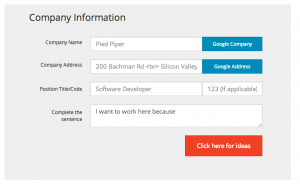The Art of Putting (Just Enough) Effort into Your Cover Letters

As it turns out, Cover Letter Tutor is the first program that Clayton has released on the Internet. “While I’m happy with it,” he wrote in an email, “My family keeps asking me how I’m going to monetize it …”
The affable Clayton, whose likes include “punk music, programming, primatology, ancient Roman history, etymology, bad coffee, and watching Youtube reviews of movies [he’ll] never see” was kind enough to agree to an interview about Cover Letter Tutor. Because the interview was carried out over email, I’ve decided to reproduce his answers below, with minimal editing.
Recruiter.com:Why did you decide to create Cover Letter Tutor?
Charles Clayton: I built it for myself. When applying for internships last spring, my university job-placement coordinator made us write sample cover letters and gave us feedback. In my sample cover letter, I mentioned the company name in the last paragraph. My coordinator explained that it was risky. Every year he saw students copy and paste certain elements and forget to change out that one mention of the company name. He was right, and many people I know did just that. That’s when I got the idea to write a program.
I also made it mandatory to include a specific reason you wanted to work at that company. It’s tempting to say “I really want to work at Microsoft”, but gloss over giving a specific reason. So instead of opening up my browser and going to Google and typing the company name and clicking the first result, with one click I made it so I was already at the company’s website in the “about” or “mission statement” section.

Cover Letter Tutor lets users search companies right from the program
For the inner content, I remember speaking to recruiters who emphasized the importance of addressing exactly what was said in the job description. If it said, “Must have strong math skills,” the company really didn’t want to hear about your written communication skills, and it concluded that you didn’t read the description.
I made a skill bank of about a dozen technical and personal skills so I could read the job description. Let’s say it said, ”Looking for someone with good teamwork skills, time management, and proficiency in C++ and technical writing.” I’d have a preset sentence or two for each of those and run through my list of skills checking “teamwork” and unchecking “self-reliance”, and checking “C++” and unchecking “JavaScript.” Then I’d press enter, and like that I’d have a formatted Word document ready to go.
Without breaking a sweat, I could make 20 applications it one evening. I got a couple interviews early on, and I got a job with a company I really love working for.
I think partly because I’m just the type of guy that will look to automate a procedure that might otherwise consume more energy than it’s worth. The reason I built it was for myself, and the reason I’ve put a new version on the Internet is because it worked for me, and I hope it can work for someone else.
R:What would you like to see people using the tool for? What kinds of people do you think could most benefit from it?
CC:Everything in the cover letter is your own content, and its quality entirely depends on the effort you put into it and the quality of your own writing. It’s just the repetition and the simple mistakes I’ve tried to help people eliminate. Without a doubt, it’s great to write each cover letter from scratch. With one company and goal in mind, you can make your letter flow smoothly and complement why you’re the perfect fit for the company.
But I don’t think it’s an efficient time-and-effort vs. reward pursuit. When it feels like a company will glance at your cover letter for mere moments, if they even look at it at all, is it really worth your time? It might be, and if you’re applying for a dream job it certainly is, but it sure doesn’t feel like it. Especially after ten applications and no callbacks. This is what worked: an easy way to increase the speed and quantity of your applications without sacrificing quality (in my biased opinion, that is). With a tool like this, you’re giving the employer exactly the information they were looking for, you’re not making silly mistakes and wasting their/your time, and you’re ensuring you find at least one thing about the company that motivates you.
The two major criticisms of the program were completely contradictory. That a) cover letters are too important to automate and not pour your heart into, and b) cover letters are outdated and worthless in this job-hunting environment, and you shouldn’t bother. I think people are pretty polarized on the topic, and I don’t find myself on either end. They’re too important to make a silly mistake on, and not important enough to consume your life.
There was a small ethical call I made when I decided to convert the program from “Cover Letter Generator” to “Cover Letter Tutor,” and start implementing changes that reflected that. It started as a way to just mass-produce cover letters for those who have already written one to work off, but I realized many people struggle even with that first one. So I wanted to give feedback and try to guide them through the process for first-time job hunters, or anyone unfamiliar with the structure.
For people looking for jobs where writing is critical, this isn’t the way to go. Maybe it’ll help you with the structure and give you a bare-bones framework to work off, but it’s not a final product by any means. But for people in other fields, where the occasionally choppy writing is not much to fret over, I think you can create some letters that are just as good as individually written ones.
R:Any plans for Cover Letter Tutor going forward? New features, revamps, etc?
CC:At the moment, you can only copy the cover letter content, then paste it into an email or a Word document or what have you. I’m working on allowing you to download it automatically as a Word document or a pdf. I also want to allow inline editing of the final product with some spelling/grammar tips, although I think Hemingway Editor is a great tool for that. (Ed. note — Clayton recently added an option to Cover Letter Tutor that allows users to run their cover letter through the Hemingway Editor.)
I have some simple ideas to start monitoring and suggesting transition words between skills or suggesting alternatives if too many sentences start with “I”. A company search that doesn’t take you away from the site would also be convenient. I’m open to suggestions from you and other experts!
Ultimately I’m a slave to demand: if people like it and continue to use it, I’d love to keep working on it. If not, I’m eager to find the next thing I want to build.

